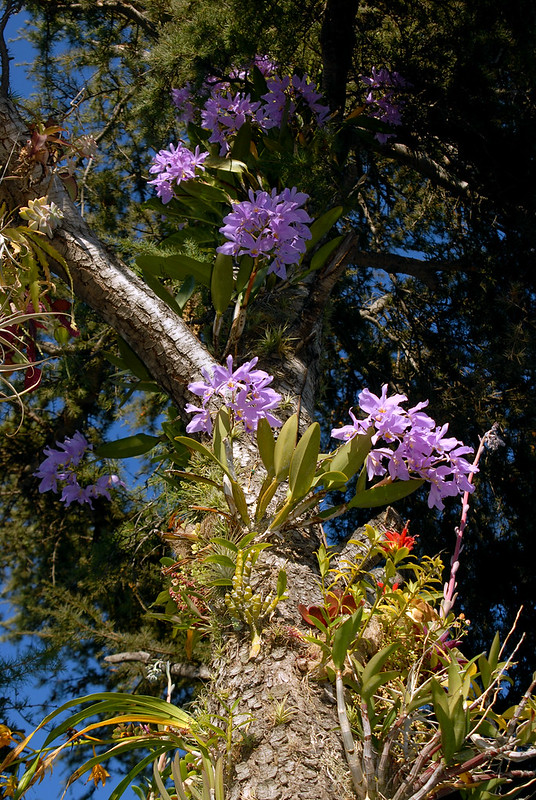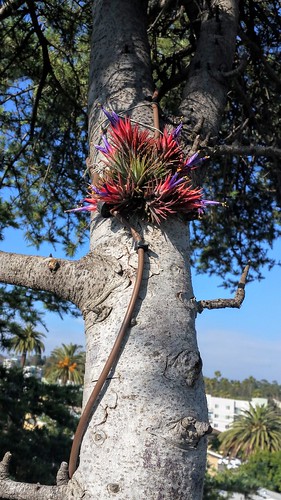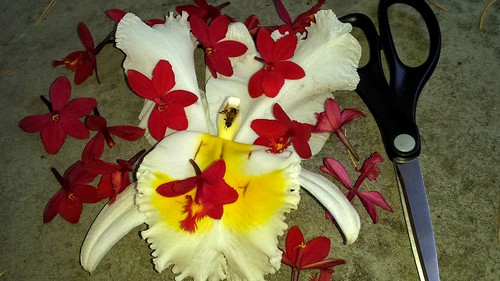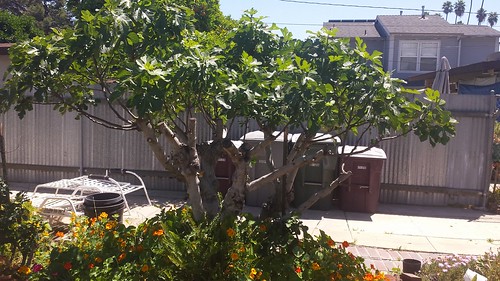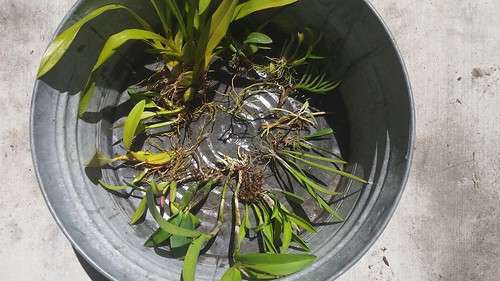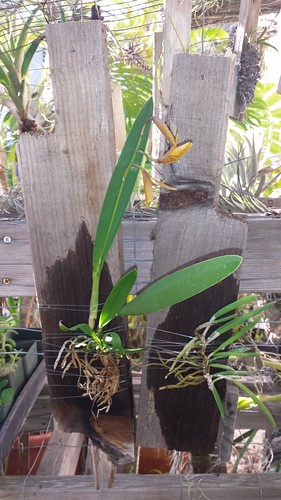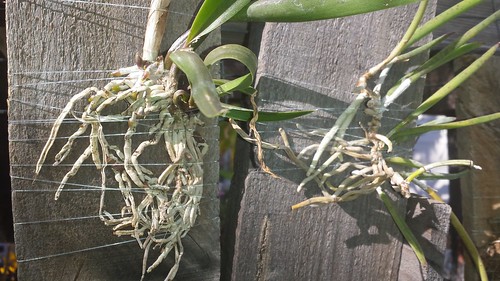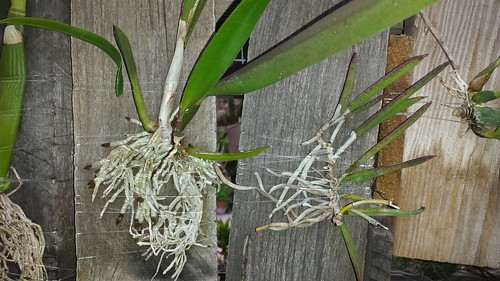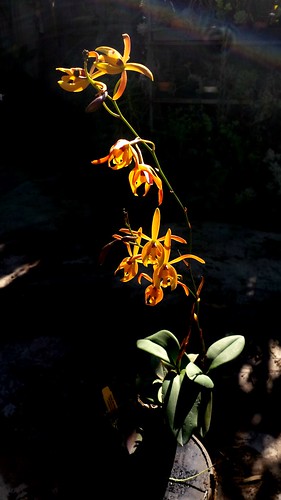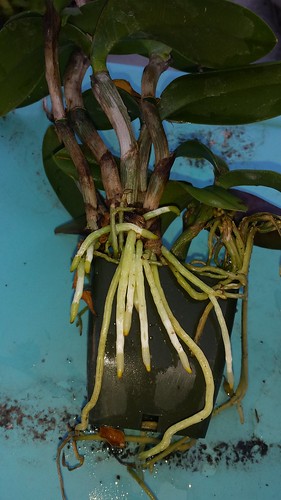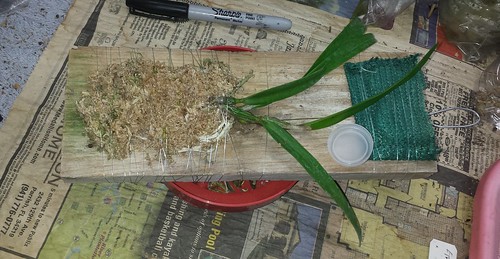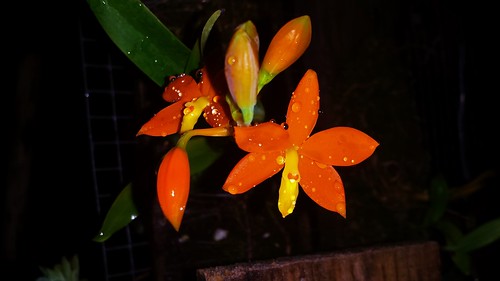In an e-mail, u u (
flickr,
OB) said that creating the perfect epiphytic orchid for SoCal is a "Herculean" goal. What's life without one, or two, or...
a dozen... Herculean goals?! But just how Herculean is this goal anyways?
For those of you who haven't been following along at home... the perfect epiphytic orchid for SoCal would be a lot like
Aloe Hercules (AH)...
-
Hercules, Hercutherm, Hybridize This and Hercules
-
Hercuthermal Experiment
Let's geek out a bit...
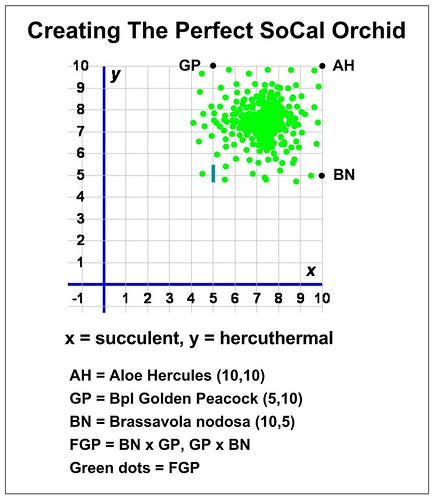
Brassavola nodosa (BN)
x = 10
y = 5
Golden Peacock (GP)
x = 5
y = 10
BN is twice as succulent as GP... but GP is twice as hercuthermal as BN. BN only grows half the year here in SoCal while GP grows the entire year. What we want is the best of both worlds! We want an orchid that needs less water to grow the entire year.
So let's imagine that we crossed GP and BN. This would give us a Fatter Golden Peacock (FGP). Here are a few basic assumptions...
1. No two FGPs would be exactly alike
2. The more FGPs there are, the more variation there will be
We've all heard the expression about the apple not falling far from the tree. It's a given that the more apples that fall from the tree... the greater the distances that some of the apples will fall from the tree. This is what I've tried to illustrate in the x y graph.
In our case, we want the apple to fall far from the tree... but in the direction of AH. The more FGPs that are produced... the greater the chances that we'll end up with a
fabulous outlier. This is known as
the law of truly large numbers.
If there's one thing that orchids are really good at, it's producing a truly large number of seeds...
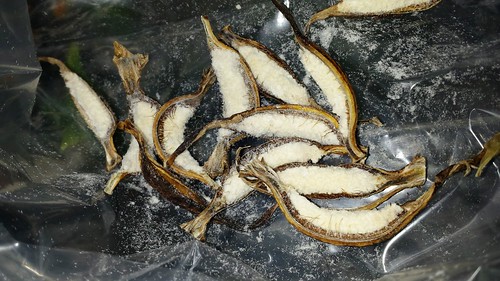
A single seed pod can contain a million seeds! A million seeds is a truly large number of seeds. I'm pretty sure that this goes a long way in explaining the success (diversity) of the orchid family.
Since orchids are exceptionally good at producing a large number of seeds, all else being equal, we should be able to make a lot more progress in a lot less time with orchids than we could make with coconuts. An average size flask of orchids can contain around 30 seedlings. But the same size flask wouldn't be large enough for even one coconut seedling. Therefore, creating the perfect orchid for SoCal should be a less Herculean goal than creating the perfect coconut for SoCal.
So how many FGP seedlings would we need to grow in order to find the fabulous outlier? A million seedlings? Maybe 300,000 seedlings? If so, that would be 10,000 flasks! That's a lot of flasks! If this is the case then...
Herculean = Expensive
In the x y graph I put AH and BN both as a 10 in terms of succulence. Clearly, in absolute terms, AH is a lot more succulent than BN. But in relative terms... perhaps they are reasonably equivalent. For some evidence that this is roughly correct, check out this photo of
a BN growing on a cactus in nature.
If you looked through that gallery of
orchids growing on succulents/cactus... you would have noticed that BN isn't the only Cattleya alliance orchid that grows on cactus. There are 100s of species in the Cattleya alliance that grow in seasonally dry forests and many of these orchids are happy to grow on the cactus that share the same habitat.
Here's a partial listing of some of the relatively drought tolerant species in the Cattleya alliance...
Barkeria (all)
Brassavola (all)
Broughtonia (all)
Cattleya nobilior
Cattleya walkeriana
Encyclia (all)
Laelia (Mexican... all)
Laelia sincorana
Myrmecophila (all)
Psychilis (all)
Rhyncholaelia (all)
Schomburgkia (all)
Sophronitis brevipedunculata
Tetramicra (all)
They all use different strategies to deal with drought. Barkerias are the only ones that are deciduous. Brassavolas are the only ones with entirely terete leaves... they also have very skinny pseudobulbs. Tetramicras have canaliculate/fleshy leaves, skinny pseudobulbs and multiple leaves on each pseudobulb. The pseudobulbs of the Rhyncholaelias aren't skinny or fat... but their leaves are relatively succulent. Psychilis do not have very fat pseudobulbs either... but neither are their leaves relatively succulent. Instead, their leaves are quite stiff (coriaceous). Myrmecophilas are the only ones with hollow pseudobulbs (for the ants to live in). Most of the others species have fat/succulent pseudobulbs but there's considerable variety in the size/shape of their pseudobulbs and in the quantity/size/shape of their leaves
One type of form that I find particularly appealing is the "teapot" form (short and stout). Encyclia pyriformis is a good example...

The plant is so short and stout! And here's a good photo that illustrates
how stout Cattleya walkeriana can be.
Given the number of...
A. species in the Cattleya alliance that occur in dry forests
B. crosses that have been made with these species
... what are the chances that BN is truly the most drought tolerant orchid in the Cattleya alliance? Pretty slim! So ideally we'd want to cross GP with both A and B in order to find the combination of traits that is closest to AH on the x y graph.
How long would it take
us to test out all these different possible combinations?! And how much money would it cost
us to flask all the seeds?! Clearly the answer depends on how many of "us" there are.
Recently a friend in Australia shared
a photo of a nice tree in Perth. As nice as the tree is... it has a pretty big problem. It's naked! The tree doesn't even have a single orchid growing on it. Perth doesn't have any native epiphytic orchids. And neither does Los Angeles.
Perth and Los Angeles have something else in common. Both cities have many people who love growing orchids...
Orchid Society of Western Australia (OSWA) and the
Orchid Society of Southern California (OSSC).
As the saying goes... many hands make light work. What if we collaborated with the OSWA to create the perfect orchid for... Southern California? For Perth? And what if we invited the members of the
Cape Town Orchid Society to join us?
Here's how I've illustrated this...
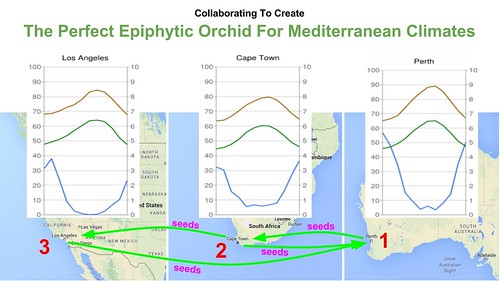
Even though each of these three cities has a Mediterranean climate... there's a considerable amount of variation in precipitation (mm/inches)...
1. Perth: 730.5 / 28.76
2. Cape Town: 515 / 20.28
3. Los Angeles: 379.2 / 14.93
Out of these three cities... the least Herculean goal would be to create the perfect epiphytic orchid for Perth. This is because Perth receives a lot more rain than Cape Town... and twice as much rain as Los Angeles.
Participants in Los Angeles and Cape Town would make promising crosses and send the seeds to participants in Perth. The participants in Perth would flask the seeds and allow their climate to select the most suitable individuals. The survivors of this selection process would be crossed with other promising candidates (recombination) and eventually the perfect epiphytic orchid for Perth would be found. Participants in Perth would send seeds of this cross to participants in Cape Town. The same selection/recombination process would eventually yield the perfect epiphytic orchid for Cape Town. The seeds of this orchid would be sent to Los Angeles and the same process would eventually yield the perfect epiphytic orchid for Southern California.
What would we call this system? Trickle down epiphytics (TDE)?
Perth, Cape Town and Los Angeles aren't the only cities with Mediterranean climates. There are quite a few other cities in the same boat. So if we want to get the ball rolling as fast as possible (maximize the rate of progress)... then we should be as inclusive as possible...












For comparison, here are the climate graphs for
Brassavola nodosa,
Barkeria barkeriola and
Laelia speciosa (
source) ...



For even more comparison, here's the climate graph for Melbourne...

Porto gets so much rain!!! *
green with envy* With as much rain as Porto gets... is there already some epiphytic orchid species or hybrid that could thrive, or at least survive, there without any supplemental watering? I'm guessing that the answer is yes. And maybe the orchid growers in Porto are already growing this orchid?
Personally, I don't know any orchid growers in Porto. And I'm guessing that I'm the rule rather than the exception. I do know
an orchid grower in Rome... but I really can't say that I'm doing a very good job of networking with other orchid growers in Mediterranean climates.
Here's a partial listing of orchid societies located in Mediterranean climates...
- Lisbon?, Portugal - Clube dos Orquidófilos de Portugal (Facebook)
- Valencia, Spain - Orquidiòfils Valencians (Facebook)
- Rome?, Italy - Associazione Italiana di Orchidologia (Facebook)
- ?, Greece - Greek Orchid Society (Facebook)
- Perth, Australia - Orchid Society of Western Australia (Facebook)
- Adelaide, Australia - Orchid Club of South Australia (Facebook)
- Cape Town, South Africa - Cape Orchid Society (Facebook)
- ?, Israel - Israel Orchid Society (Facebook)
- San Francisco, United States - San Francisco Orchid Society (Facebook)
- Los Angeles, United States - Orchid Society of Southern California (Facebook)
Maybe we should create a Facebook page/group for orchid growers in Mediterranean climates?
Googling around I found this photo
in Wikipedia commons....

The photo was taken by Marcia Breia in Cordoaria Garden which is in Porto, Portugal. The tree is the London plane tree (
Platanus × acerifolia). The truck is so big, fat and mossy! It would be perfect for an orchid... or two.
We would certainly linger longer and be more inclined to take a photo of this tree if it had an orchid growing on it. But not only would this specific space be more appealing, it would also be more diverse.
Regarding the value of diversity...
Biological diversity is a natural protection against surprises and shocks, climatic and otherwise. Among diverse species will be some adapted to prosper in a new landscape in new circumstances. - Daniel J. Evans et al, Policy Implications of Greenhouse Warming: Mitigation, Adaptation, and the Science Base
More genetic variety in a species or a population means a higher likelihood that some individuals will adapt to changing conditions. Lower genetic variety results in uniformity of species, and ultimately translates into vulnerability.
As an example, modern agricultural practices typically are monocultures - the practice of planting vast swathes of genetically identical plants. This is an advantage when it comes to growing and harvesting crops, but it can be a problem when a disease or parasite attacks the field, as every plant in the field will be susceptible. Monocultures are also unable to deal well with changing conditions, such as the changing percipitation and temperature regimes associated with climate change. - Sarah L. Burch, Sara E. Harris, Understanding Climate Change: Science, Policy, and Practice
Regarding our natural preference for orchid diversity...
One would think that man could find enough variation in the orchid family, as it occurs in nature, to more than satiate his taste for variety. Yet man's appetite for variety is never appeased. He has produced over two times as many hybrids, in the past 100 years that he has been engaged in orchid breeding, as nature has created species in her eons of evolutionary effort. - Calaway H. Dodson, Robert J. Gillespie, The Botany of Orchids
Regarding our natural preference for collecting/sharing...
The absence of [Dendrobium johannis var. semifuscum] from the mainland of the Northern Territory and its presence on Melville and Bathurst islands leads to the speculation that it might have been introduced to the islands by Macassamen (trepang fishermen) who were known to plant all manner of things on some of the places they visited during their travels. - A. W. Dockrill, Australian Indigenous Orchids
People collect baseball cards and people collect plant seeds. In reality, it is not all that surprising that as people move around they help preserve the genetic diversity of plants. - Norman C. Ellstrand, Maize Germplasm Conservation in Southern California’s Urban Gardens: Introduced Diversity Beyond ex situ and in situ Management
A far less technical way of preserving a species is in gardens. Although the managers of botanical gardens or arboreta are more self-conscious of their role, any gardener can help. The wide cultivation of Bougainvillaea and the para rubber tree, for example, protects them from extinction in tropical America. By collecting and breeding novel plants, nurserymen preserve biological diversity. By selling novel plants, they diversify the places the plants are grown and so help preserve them. - Daniel J. Evans et al, Policy Implications of Greenhouse Warming: Mitigation, Adaptation, and the Science Base
Regarding the virtuous cycle of diversity...
Thus, the total diversity of an area provides the pool of competitors for niches in developing ecosystems. The larger the pool, the more likely it is that the system will evolve into a complex, highly interrelated system. And complex, highly interrelated systems provide more niche opportunities for new species. Over time, interspecific dependencies, both of predation and mutualism, will evolve. Further, interspecific competition often aids in avoiding competitive exclusion, as predators concentrate on the competitively advantaged species on any given trophic level. Thus, total diversity plays a key role in the development of ecosystem structure through ecological time. That structure, in turn, provides opportunities for more species to survive and thereby increases total diversity further. Therefore diversity augments diversity in a continuing upward spiral. - Bryan G. Norton, The Preservation of Species
Creating the perfect epiphytic orchids for Mediterranean climates would mean that lots of people would attach these orchids to trees. Because, just like AH... they would require very little supplemental water to grow year around. All these orchids on trees would create new niches for a wide variety of living things. The logical and beneficial outcome would be more diversity.
Right now there are thousands and thousands of people growing millions of epiphytic orchids in Mediterranean climates. All these epiphytic orchids require more supplemental water than AH requires. And because people often don't have the time, or energy, to consistently and regularly water their epiphytic orchids... many epiphytic orchids are killed from dehydration. Basically, people unintentionally help nature select for the most drought tolerant and hercuthermal epiphytic orchids. This means that we will
eventually end up with the perfect orchids for Mediterranean climates. Personally, I'd love to have these orchids sooner rather than later!!! It's really hard to imagine that I'm the only person in this boat! So
in theory, it shouldn't be a Herculean goal to encourage people to help create/buy/test/share epiphytic orchids that might be better suited for Mediterranean climates.
